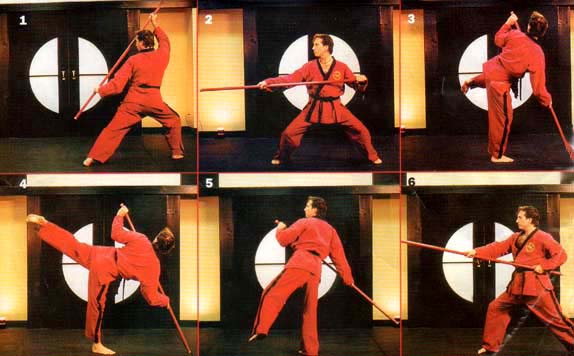Wind Devil Staff
How To Perform Spinning Staff and Kicking Combinations
By Stefan Verstappen, Originally published in Inside Kung Fu Magazine July 2000
 Imagine a weapon that is rugged and durable, has multiple uses and applications, is light, easy to carry, low maintenance, costs nothing at all, and can be found almost anywhere. Only the humble stick meets these requirements.
Imagine a weapon that is rugged and durable, has multiple uses and applications, is light, easy to carry, low maintenance, costs nothing at all, and can be found almost anywhere. Only the humble stick meets these requirements.
Usually thought of as the country cousin of the more civilized weapons like the sword and halberd, the staff’s economy was just one of several reasons it became the trademark tool and weapon of wandering monks in China and throughout Asia.
Actually it was because monks had to wander that the staff was so favored. Upon entering the monastery, novice monks spent anywhere from two to three years studying under an Abbott to learn the basic tenants of Buddhism. After this training period many monks returned to secular life to raise families often retiring to the monastery in old age. But those who wanted to continue were required to spend a minimum of two years on a kind of pilgrimage visiting various temples and monasteries all across the country.
 China’s rugged and mountainous terrain insured that anyone traveling cross-country would have to spend many days and nights in the open wilderness between villages and lodgings. The staff was thus a useful tool for traveling along slippery mountain paths, testing the depth of a stream, or fending off the local wildlife. There was another hazard of mountain travel that the staff was useful against and that was the notorious bandits that have menaced China’s lonely high roads for thousands of years.
China’s rugged and mountainous terrain insured that anyone traveling cross-country would have to spend many days and nights in the open wilderness between villages and lodgings. The staff was thus a useful tool for traveling along slippery mountain paths, testing the depth of a stream, or fending off the local wildlife. There was another hazard of mountain travel that the staff was useful against and that was the notorious bandits that have menaced China’s lonely high roads for thousands of years.
While merchants and well heeled travelers hired armed martial arts experts as guards against the robbers, Buddhist monks had neither the money to hire protection, nor were they allowed to carry any kind of weapon. The taking of a life, even in self defense, was expressly forbidden. Buddhists felt that carrying a weapon implied a willingness to use it and thus a willingness to kill. Since a staff does not have any cutting edges, and its primary use was as a tool, it was thus exempt from the no weapons rule. That it would occasionally come crashing down on some bandit’s head could be forgiven if the whack had helped nudge the bandit a little farther down the road to enlightenment.
Given the staff’s versatility it is little wonder that the monks developed a extraordinary range of techniques for what is just a simple wooden pole. In the number of applications and uses the staff is far more complex and versatile than any other weapon ancient or modern. While usually considered a long range weapon there are also techniques that are effective at medium and short ranges. Because solo drills and forms emphasize the staff’s long range techniques the knowledge of, or need to learn, the other two ranges of techniques doesn’t become apparent until one engages in free form sparring.
When teaching the staff to advanced students I always require them to undergo free form contact sparring against another staff. For safety we use light padded poles and hockey helmets but, even with this equipment, if you receive a good whack it will leave a welt or rattle your brains. Ten minutes of free sparring will drive home the point of two years of forms practice and one thing students figure out real fast is that the way to beat the staff is to get inside it’s long range techniques. This often results in situations where both fighters find their weapons entangled in a stalemate. These stalemates can be overcome if one fighter switches tactics entirely and resorts to either a close range throwing, or medium range kicking technique. However almost no novice staff fighter will use his legs until taught to do so.
By the time martial arts students reach the point of training with a weapon they have had several years of mastering hand and foot techniques, yet when handed a staff and told to defend themselves, many will refrain from using their feet. By learning and practicing kicking combinations with the staff, students will easily be able to learn and use tactics few opponents would anticipate. There is another benefit to using a staff in combination with kicking techniques since the staff helps overcomes a kick’s major drawback, lack of balance. In the following techniques the staff is used to replace the foot that is being used to kick. This adds a great deal of balance, control, and power that is not evident in photos. When you learn these combinations you can see for yourself the amazing improvement in your kicks when you use the staff to take some of the body’s weight and absorb the recoil from a kick hitting its target.
The following two combinations have been attested to their effectiveness in the sparring ring and can add a unique and spectacular addition to your weapons routine. Since both the staff techniques and kicks are circular and mutually interchangeable they can be used as drills. The continuous flowing spins that intersperse slashing staff strikes with arching kicks, done fast enough, gives the practitioner the appearance of a dust devil, hence the name wind devil to describe this category of techniques.
Safety First
When practicing the combinations solo it doesn’t matter what type of staff you use, but if practicing applications with a partner use either rattan, or Chinese white wax wood. The reason is these woods are flexible and will give under the impact of another weapon. Hardwoods and PVC type plastics are often brittle and will break when you least expect it. Once, when practicing a high block with the staff against an overhead strike, the top eight inches of the attacking student’s maple wood staff broke off into a sharp shard which whipped down fast enough to cleanly cut open the cheek of the defending student. Another inch over and he would have been blinded in one eye. After that we used rattan staffs and eye protection.
The Grip
Unlike the Japanese grip, where there is an equal amount of staff extending from both hands, the Chinese grip is closer to one end of the staff allowing the longer section to extend from the lead hand. Chinese staff techniques thus resemble, and are often identical to, spear or lance techniques. There are two variations on the Chinese grip. The first is with the left hand leading and the second is with the right hand leading. While most of the 18 Lohan methods favor the latter grip, there are several grip changes incorporated in the form so that techniques from both variations are covered. In the following photographs the grip used is right hand leading with both thumbs pointing forwards. However these combinations do not require any specific grip and so you can use whichever grip you’re already used to.
The Kick
The two kicks used in this article are the spinning side, and the spinning hook kick. In most styles these are intermediate level techniques and so beginners would need to learn these first before learning the following combinations. In the 18 Lohan style the supporting foot pivots a 180 degrees so that the toes point away from the kicking leg. In other words if you kick a target at 12 O’clock your other foot should be pointing to 6 O’clock. This is important for coordinating where the staff end will be planted.
The Plant
Regardless of which leg is kicking or which end of the staff is being planted, the spot where you plant the staff is always the same, and that is in-line with both the supporting leg and kicking leg. This position maximizes both balance and power. In this alignment kinetic energy travels from the pole and supporting leg in a straight line through the kicking leg and into the target. When first learning these combinations many students neglect to pay attention to the spot where they plant the staff and as a consequence often land on their butts. If you plant off the line one way or the other the `push’ from the staff will throw you off balance. In the beginning use your focus on where you plant the end first, then after you develop a feel for the correct positioning, go on and concentrate on the kick itself. (See illustration.)
Final Pointers
Beginners will tend to look down at the staff and kick `blindly’. Remember the plant should become second nature then, when you kick, your entire focus is on the target. With a little practice you should be able to perform these combinations smoothly and with little effort.
Power is generated through the pole and the centrifugal forces generated through the spin. If you tense up or try to exert strength you will interfere with the natural flow of the technique and defeat your own purpose. Mastering these two combinations is only the beginning since there are a half dozen variations that can be developed from them. It is now up to your imagination and creativity to discover where and how to use them.